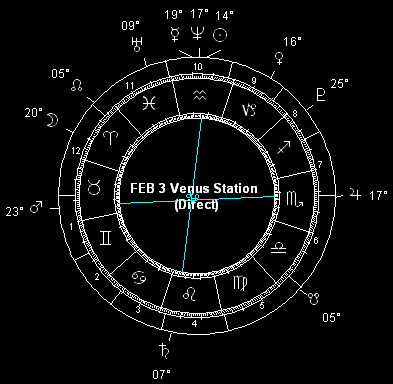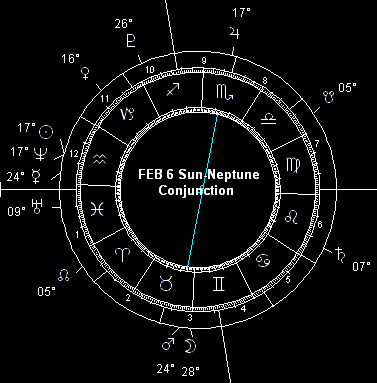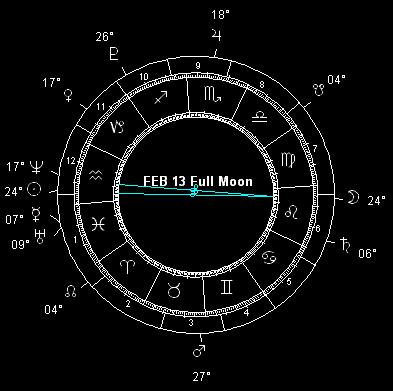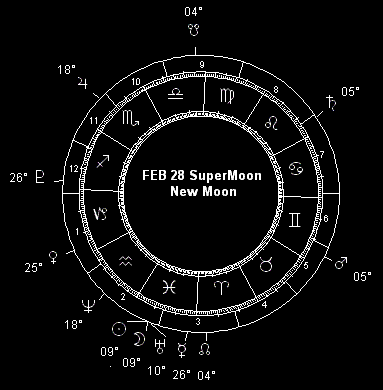If you were expecting some kind of sun sign nonsense, forget about it. This is real astrology for the real world. If it's real astrology for yourself that you want, you can get it by phone or in print. And if you need help deciphering the astrological glyphs in the graphics accompanying this article, see Astroglyphs: Astrological Symbols Guide. Please note: this forecast is expressed in terms of Universal Time (UT).
These things are in the future; we needs must do what lies at hand.
-- Sophocles
 February starts and finishes under the aegis of some major geocosmic stress factors. That means a surfeit of moderate to severe seismic disturbances, big storms with high winds and heavy precipitation (in some cases leading to landslides, mudslides, avalanches etc.); plus extreme tidal surges along the coastlines. From the lingering shadow of the January 29 SuperMoon, with its geocosmic risk window extending through February 3, to the SuperMoon at the very end of February (not to mention the full moon on the 13th), this will be a turbulent and storm-tossed month - details to follow. But first . . .
February starts and finishes under the aegis of some major geocosmic stress factors. That means a surfeit of moderate to severe seismic disturbances, big storms with high winds and heavy precipitation (in some cases leading to landslides, mudslides, avalanches etc.); plus extreme tidal surges along the coastlines. From the lingering shadow of the January 29 SuperMoon, with its geocosmic risk window extending through February 3, to the SuperMoon at the very end of February (not to mention the full moon on the 13th), this will be a turbulent and storm-tossed month - details to follow. But first . . .
While it's bound to be a headliner, natural upheaval is far from the whole story for February. Another noteworthy cosmic marker for the month comes when Mercury in its evening star phase attains its greatest elongation east of the Sun on the 23rd, beginning this planet's intersolar period; i.e. the segment of its orbit which lies between Earth and the Sun. (If this sounds a little abstract, I'm hoping the accompanying animation I have prepared will help clarify things.) The intersolar cycle includes the little planet's retrograde, when Mercury appears to reverse its normal course through the sky, as this swift inner planet catches up and passes the slower-moving Earth on the 'inside track' as it were. This time around, the retrograde begins and ends in March (with the retrograde station on the 2nd and the direct station on the 25th respectively), and includes Mercury's pass directly between Earth and Sun to form its inferior conjunction with the Sun on March 12. The intersolar cycle as a whole extends to Mercury as morning star reaching its maximum elongation west of the Sun on April 8.
As you can see from the animated diagram, Mercury is much closer to Earth than usual during its intersolar phase. This is nature's way of telling us that all things mercurial are a higher than normal priority at these times. The mercurial elements of human experience are thought, communication, commerce and transportation, primarily: these will be prominent themes during the February 23-April 8 Mercury intersolar period. People who see it coming, who prepare and act accordingly, will prosper during this cycle. But those who are asleep at the switch will end up falling farther and farther behind. So plan, study, research, gather information and documentation in advance, and have fallback positions ready. Anticipating the importance of all that is mercurial means being alert, paying attention, being sharp and perceptive. Assume nothing, follow up on everything; stay informed, in touch and on top. And starting with the beginning of Mercury's intersolar cycle on the 23rd, that's exactly what the smart people do. Those who don't will get caught up in the miasma of missing information, missed connections and all kinds of messes and delays.
You'll see it starting on the 23rd: strikes and other disruptions affecting transportation and communication (e.g. postal, phone, mass transit, trucking, airline, shipping, dock and warehouse workers, teachers and all manner of media). Weather both terrestrial and solar (including geomagnetic storms) can play a part in the kind of breakdowns described here, but human effort (and sometimes malicious action) is a part of the mix as well. Power failures due to infrastructure breakdown and computer network disruptions caused by hacker attacks, software vulnerabilities and the like are also just a crossed wire or a keystroke away from a major mess at these times. It's not so much that disaster is destined to strike when Mercury is in its intersolar phase. Rather, it's that everything pertaining to Mercury becomes crucial; and unless it's treated as such, then it goes awry. Unfortunately, few people keep their eye on the ball with any consistency and diligence. Most people spend most of their lives sleepwalking around on autopilot. And that's the reason these Mercury cycles tend to turn into Murphy's Law festivals.
 The planets inside Earth's own orbit are, by definition, the only ones that can have an intersolar cycle as seen from our home planet. While Mercury begins its first intersolar cycle of the year late this month, Venus spends the whole of February intersolar. The current Venus intersolar cycle began on November 3, 2005 as the "evening star" (Venus Vesper) attained maximum elongation east of the Sun. The cycle continues through Venus' retrograde (backwards motion as seen from Earth), which began on December 24, 2005 and continues through February 3, 2006. The most intensive phase of this cycle was likely the inferior conjunction with the Sun on January 13, 2006; when Earth, Venus and Sun all lined up with Venus between Earth and Sun. (The Dow Jones index broke 11,000 for the first time in 4-1/2 years within a few days of this highly favorable conjunction. As the alignment began pulling apart, the Dow suffered its worse single-day loss in more than three years on the 20th.) The cycle wraps up on March 25, 2006, as Venus Lucifer (the "morning star") attains maximum elongation west of the Sun and passes behind the plane of the Sun as seen from Earth.
The planets inside Earth's own orbit are, by definition, the only ones that can have an intersolar cycle as seen from our home planet. While Mercury begins its first intersolar cycle of the year late this month, Venus spends the whole of February intersolar. The current Venus intersolar cycle began on November 3, 2005 as the "evening star" (Venus Vesper) attained maximum elongation east of the Sun. The cycle continues through Venus' retrograde (backwards motion as seen from Earth), which began on December 24, 2005 and continues through February 3, 2006. The most intensive phase of this cycle was likely the inferior conjunction with the Sun on January 13, 2006; when Earth, Venus and Sun all lined up with Venus between Earth and Sun. (The Dow Jones index broke 11,000 for the first time in 4-1/2 years within a few days of this highly favorable conjunction. As the alignment began pulling apart, the Dow suffered its worse single-day loss in more than three years on the 20th.) The cycle wraps up on March 25, 2006, as Venus Lucifer (the "morning star") attains maximum elongation west of the Sun and passes behind the plane of the Sun as seen from Earth.
As predicted in my World Forecast Highlights for last year, the current Venus intersolar cycle coincided with "an undercurrent of economic growth" in late 2005. So far, also as predicted, it's continuing into early 2006 and it has been "especially good for copper, gold and silver; for jewelry and fashion, for the entertainment industry." Also per my forecast, gold and silver have been "a complicated proposition, what with favorable lunar declination factors and an unfavorable Saturn transit": so we've seen these two precious metals trading in a range where ups mean hold and downs mean buy. Remember, as mentioned when discussing the favorable associations of the Venus intersolar cycle for last year's forecast, that "there are other indicators of a less favorable nature, so no one should expect unmitigated economic and financial improvement on a broad scale. Horrid oil price shocks will play havoc with the world economy off and on." This is even more the case in 2006, so make hay while Venus remains between us and the Sun.
 By late March, what favorable economic tides there have been, are beginning to ebb - just as the benefic Venus cycle itself fades away. But blue chips in general and financials in particular (also mines) should continue to look relatively strong this month - though probably not quite as strong as they did, per my forecast, in January. The upward momentum may well have peaked for equities around the time of the January 13 Sun-Venus inferior conjunction, but it hasn't disappeared yet. It may be noticeably weaker, more likely to be interrupted by sell-offs, after the February 3 Venus direct station. February 3-6, give or take a few days either way, looks pretty dicey in the markets, what with the Venus station plus Mercury's square to Mars on the 5th and the Sun square to Jupiter and alignment with Neptune the following day. But there are still buyers out there. Which means you'll have an opportunity to buy on the dips and, unless it's gold or silver, sell on the peaks during this period - gold and silver are for keeps for now.
By late March, what favorable economic tides there have been, are beginning to ebb - just as the benefic Venus cycle itself fades away. But blue chips in general and financials in particular (also mines) should continue to look relatively strong this month - though probably not quite as strong as they did, per my forecast, in January. The upward momentum may well have peaked for equities around the time of the January 13 Sun-Venus inferior conjunction, but it hasn't disappeared yet. It may be noticeably weaker, more likely to be interrupted by sell-offs, after the February 3 Venus direct station. February 3-6, give or take a few days either way, looks pretty dicey in the markets, what with the Venus station plus Mercury's square to Mars on the 5th and the Sun square to Jupiter and alignment with Neptune the following day. But there are still buyers out there. Which means you'll have an opportunity to buy on the dips and, unless it's gold or silver, sell on the peaks during this period - gold and silver are for keeps for now.
Another March phenomenon that reaches back into February is Jupiter's March 4 retrograde station at 18° 52' Scorpio, playing into the year's signature T-square configuration. The giant planet is within a degree of that station point from February 7 onward; and within a degree of its January 29 and March 16 squares to Neptune throughout February. (The full moon at 24 Aquarius-Leo on the 13th also plays into the aforementioned T-square, and brings Mars into a Grand Cross as well.) While the exact aspect dates represent target times for the oil price and supply shocks suggested by these configurations, it's never wise to make a fetish of exact dates. This is a system on the brink, and it won't take much to put it into a spasm. Moreover, Jupiter and Neptune are two of the keynote planets in the great 2006 T-square, so there's a lot more involved than petroleum. This is about banking, credit, the financial system; about confidence and trust, and how these things erode in time if they're not cultivated and reinforced. This isn't 'the Big One', it's only a tremor; a foreshock. The walls won't come crashing down now, but the cracks will be obvious and growing sometime this month or next. Plastering this stuff over is not the solution, but it's the best the people in charge can offer at this point.
And then there's the pair of squares to Mars this month. The first is the previously mentioned Mercury-Mars square at 24° 13' Aquarius-Taurus on the 5th, which ties into the solar aspects to Jupiter and Neptune the following day. It's a combination that seems to point to disruptions in energy distribution due to infrastructure damage, shipping delays, sabotage, terror strikes or threats and the like. A similar portent is the February 19 Sun-Mars square in the first degrees of Pisces and Gemini respectively. Both of these aspects to Mars raise a risk window that extends at least a few days either side of the exact dates. These are times of bold or even rash action, short fuses and hot tempers - probably not hugely threatening, but good times for caution and preventive measures.
 As for February's major geocosmic stress factors, they're there from the start. The January 29 SuperMoon risk window extends through February 3, thanks to a combination of factors including the Moon's northward equatorial crossing on February 2. As described in last month's forecast, throughout this period, there will be an increased likelihood of strong storms with high winds and heavy precipitation. Extreme high tides and heavy surf along the coasts, floods, avalanches and mudslides inland, and an elevated risk of moderate to severe seismic activity (Richter 5+ quakes, volcanic eruptions): the news will be full of such. Stay safe and be ready - no matter where you live. You might even want to be extra vigilant and prepared if you'll be in a zone where significant astrological factors are emphasized during this SuperMoon. A look at the astro-locality map points out a number of such hot zones. These include Alaska and the Aleutians, and a north-south zone from the Baja Peninsula and northern Mexico into southern California and Nevada, up through eastern Oregon and Washington and on into Alberta; plus a northeasterly swath that includes Santa Fe, Denver and Bismarck and tops out across southern Greenland before heading west and south through Iceland, Scandinavia, western Russia and Ukraine, down through Turkey and the Middle East. There are also a couple of risky-looking north-south lines that cut through Afghanistan and Pakistan, another pair across eastern Japan, and a whole gaggle of them converging on Papua New Guinea and eastern Australia.
As for February's major geocosmic stress factors, they're there from the start. The January 29 SuperMoon risk window extends through February 3, thanks to a combination of factors including the Moon's northward equatorial crossing on February 2. As described in last month's forecast, throughout this period, there will be an increased likelihood of strong storms with high winds and heavy precipitation. Extreme high tides and heavy surf along the coasts, floods, avalanches and mudslides inland, and an elevated risk of moderate to severe seismic activity (Richter 5+ quakes, volcanic eruptions): the news will be full of such. Stay safe and be ready - no matter where you live. You might even want to be extra vigilant and prepared if you'll be in a zone where significant astrological factors are emphasized during this SuperMoon. A look at the astro-locality map points out a number of such hot zones. These include Alaska and the Aleutians, and a north-south zone from the Baja Peninsula and northern Mexico into southern California and Nevada, up through eastern Oregon and Washington and on into Alberta; plus a northeasterly swath that includes Santa Fe, Denver and Bismarck and tops out across southern Greenland before heading west and south through Iceland, Scandinavia, western Russia and Ukraine, down through Turkey and the Middle East. There are also a couple of risky-looking north-south lines that cut through Afghanistan and Pakistan, another pair across eastern Japan, and a whole gaggle of them converging on Papua New Guinea and eastern Australia.
Following the year's first SuperMoon turbulence, the next geocosmic risk window runs from the 7th through early on the 17th. It's kicked off by the Moon's north declination maximum on the 8th, which melds into the February 13 full moon, which in turn trails into the Moon's southward equatorial crossing on the 16th. Expect a bout of storminess and seismic disturbances; probably less extreme than those at the beginning and end of the month, but nothing to sneeze at in any case. Strike/slip faults are more than usually vulnerable during this full moon event. The San Andreas fault is perhaps the best known example of this type of fault structure, but it doesn't look especially vulnerable during most of this particular stress window - except for the 16th, give or take about 24 hours. Have your candles, canned goods, fresh batteries and bottled water handy, just in case. As always, this being a planetary configuration, the target zone is planetary in scale. While most of us don't live anywhere near a fault line or a volcano, no place on Earth is beyond the reach of severe weather. So have your emergency plans and supplies prepared - maybe especially if you'll be watching the full moon from Hawaii, Alaska and the Aleutians, Central America (along a longitude extending north to Atlanta, GA and from there into the Midwest and Ontario), west central South America along the longitude of Caracas (which passes through San Juan, PR and northward to the Atlantic coast of Canada) . . . to name just a few of the astro-locality target lines that also run through Iceland, Greece and the Balkans (anywhere along the longitude of Capetown, SA), Egypt and Turkey, and along the longitude of Hong Kong (including Indonesia and the west coast of Australia).
 Starting a little ahead of the Moon's south declination extreme on the 23rd, running through this year's tightest lunar perigee (Moon's closet approach to Earth) on the 27th and the February 28 SuperMoon and continuing a little past the Moon's March 1 northward equatorial crossing, the last geocosmic stress window extends from February 21 through March 3. As I mentioned in my 2006 World Forecast Highlights, I figure that monstrously powerful windstorms appear to be the strong suit of this particular cycle, but the normal meteorological and seismic risks will still apply. Danger to ships and planes in transit on and over water seems greater than usual around the time of the SuperMoon on the 28th. With Mercury and Venus now both intersolar as well, commercial transportation appears subject to unusual disruptions - some of which is weather related, but not all of it. Travelers take care, and be prepared for delays.
Starting a little ahead of the Moon's south declination extreme on the 23rd, running through this year's tightest lunar perigee (Moon's closet approach to Earth) on the 27th and the February 28 SuperMoon and continuing a little past the Moon's March 1 northward equatorial crossing, the last geocosmic stress window extends from February 21 through March 3. As I mentioned in my 2006 World Forecast Highlights, I figure that monstrously powerful windstorms appear to be the strong suit of this particular cycle, but the normal meteorological and seismic risks will still apply. Danger to ships and planes in transit on and over water seems greater than usual around the time of the SuperMoon on the 28th. With Mercury and Venus now both intersolar as well, commercial transportation appears subject to unusual disruptions - some of which is weather related, but not all of it. Travelers take care, and be prepared for delays.
In seismically active areas, an upsurge in moderate to severe earthquakes (Richter 5 and up) and volcanic eruptions would be par for the course at times like this. Coastal interests should prepare for higher than normal tides and heavy surf. Inland flooding, landslides and avalanches due to unusually heavy precipitation can happen over wide areas, wherever storms can reach - which is to say, just about anywhere at all. Still, the Great Plains from Alberta down through Texas and into central eastern Mexico are one of the major astro-locality map high risk sectors for this SuperMoon; also the Aleutian Islands and a north-south swath from central Greenland down through the eastern tip of Brazil; and, on the other side of the world, from eastern Australia and Papua New Guinea up through eastern Japan. Another north-south danger zone runs right through Delhi, another goes from Edinburgh down through Madrid and across West Africa, and the last of the major north-south risk lines for the February 28 SuperMoon runs through Wellington, New Zealand. And finally, there's an arc of instability that runs northeasterly through western Africa, across the Mediterranean and Florence, through eastern Europe and across northern Russia, curving southward to cross northern Japan and then into the Pacific.
 SPECIAL FEATURE: This month's birthdays of the famous and infamous (with astrological birth charts)
SPECIAL FEATURE: This month's birthdays of the famous and infamous (with astrological birth charts)